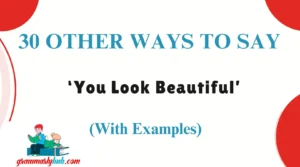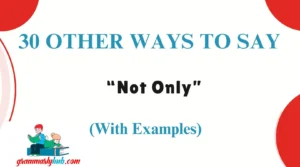When expressing personal thoughts, the phrase “in my opinion” is commonly used—but repeating it too often can sound monotonous or overly casual. Fortunately, there are many other ways to say “in my opinion” that can add variety, tone, and professionalism to your writing or speech. Whether you’re contributing in a meeting, writing an essay, or joining an online discussion, using alternative phrases like “I believe,” “from my perspective,” or “it seems to me” can help convey your thoughts more effectively.
These expressions not only communicate your stance clearly but also show respect for differing viewpoints. In this article, we’ll explore synonyms for “in my opinion” that suit both formal and informal situations, complete with examples and tips on when to use each. Let’s dive into fresh, thoughtful ways to express yourself with clarity and confidence.
What Does “In My Opinion” Mean?
“In my opinion” is a phrase used to show that what follows is a personal belief, perspective, or interpretation—not a universal fact. It helps soften statements and encourages respectful dialogue by clarifying that you’re sharing your view, not imposing it.
When to Use “In My Opinion”
Use “In my opinion” when:
- You’re offering a viewpoint or belief.
- You want to show humility or avoid sounding bossy.
- You’re writing or speaking diplomatically.
- You want to distinguish a personal take from an objective statement.
Is It Professional/Polite to Say “In My Opinion”?
Yes, it is! Saying “in my opinion” is both professional and polite, especially in business, academic, or collaborative environments. It shows respect for other viewpoints while clearly expressing your own. However, depending on tone or repetition, using synonyms can make your message more varied and dynamic.
Pros and Cons of Saying “In My Opinion”
Pros
- Polite and respectful
- Clear about ownership of the thought
- Encourages open discussion
Cons
- Can feel repetitive or formal if overused
- May weaken confident statements if used too often
- Less direct than some alternatives
Synonyms For In My Opinion
- I think
- I believe
- From my perspective
- I feel that
- It seems to me
- If you ask me
- In my view
- Personally speaking
- To me
- My take is
- What I believe is
- Speaking for myself
- I’d say
- I hold the view that
- I’m of the opinion that
- From where I stand
- As I see it
- To my mind
- In my estimation
- It’s my belief that
- The way I see it
- I’m convinced that
- It’s clear to me that
- As I understand it
- It appears to me that
- To be honest
- In my personal view
- In all honesty
- My honest opinion is
- Here’s how I see it
1. From my perspective
Definition: A way of stating what you believe based on your point of view.
Explanation: It adds a slight emotional or experiential tone, suggesting your view is based on how you see things.
Example: “From my perspective, that strategy isn’t sustainable long term.”
Worst Use: In overly objective or data-heavy discussions.
Tone: Thoughtful, personal.
2. I believe
Definition: A confident expression of personal conviction or thought.
Explanation: Shows that the speaker holds the view strongly but politely.
Example: “I believe this approach will generate better results.”
Worst Use: May sound preachy if repeated too much.
Tone: Respectful, assertive.
3. I think
Definition: A simple, casual way to express your opinion.
Explanation: Common in spoken and written English; less formal than “I believe.”
Example: “I think the design could be improved with brighter colors.”
Worst Use: In formal or academic writing.
Tone: Conversational, easygoing.
4. To me
Definition: Short and casual expression of a personal view.
Explanation: Puts emphasis on personal reaction or interpretation.
Example: “To me, it feels like the story ended too soon.”
Worst Use: In formal presentations or documents.
Tone: Informal, subjective.
5. As far as I’m concerned
Definition: Highlights that what follows is strictly your view.
Explanation: Can sound firm or slightly defensive depending on tone.
Example: “As far as I’m concerned, we’ve done all we can.”
Worst Use: When trying to build consensus.
Tone: Assertive.
6. In my view
Definition: A refined, professional way to say “in my opinion.”
Explanation: Used often in writing and public speaking.
Example: “In my view, the proposal aligns with our long-term goals.”
Worst Use: Overuse may make it sound formulaic.
Tone: Polished, neutral.
7. It seems to me
Definition: Suggests uncertainty or open-mindedness.
Explanation: Useful when presenting tentative ideas.
Example: “It seems to me that customers prefer simpler layouts.”
Worst Use: When you need to sound decisive.
Tone: Tentative, open.
8. Personally speaking
Definition: Indicates you’re about to share a personal take.
Explanation: Helps signal that the opinion is your own, not your group’s.
Example: “Personally speaking, I’d prefer if we delayed the launch.”
Worst Use: Can feel redundant with “I” statements.
Tone: Friendly, humble.
9. If you ask me
Definition: Informal way to share your opinion, often unprompted.
Explanation: Great for casual chats or friendly debates.
Example: “If you ask me, that movie was way too long.”
Worst Use: In formal writing or serious discussions.
Tone: Conversational.
10. My take is
Definition: A casual, modern way to express your viewpoint.
Explanation: Often used in discussions, commentary, or social media.
Example: “My take is we need a stronger call to action.”
Worst Use: Not suitable for academic or formal documents.
Tone: Contemporary, relaxed.
11. What I believe is
Definition: An assertive way to introduce a personal belief or viewpoint.
Explanation: Emphasizes that the following statement is rooted in your belief system.
Example: “What I believe is that transparency builds stronger teams.”
Worst Use: May come off as rigid if used repeatedly in group settings.
Tone: Confident, direct.
12. Speaking for myself
Definition: A clear marker that you’re not speaking for others.
Explanation: Useful in group discussions where multiple perspectives are involved.
Example: “Speaking for myself, I find the changes refreshing.”
Worst Use: When speaking on behalf of a team or group.
Tone: Respectful, independent.
13. I’d say
Definition: A casual, less formal version of offering an opinion.
Explanation: Implies room for other interpretations, keeping tone relaxed.
Example: “I’d say we should test this version first.”
Worst Use: In formal reports or academic writing.
Tone: Light, flexible.
14. I hold the view that
Definition: A formal and articulate expression of an opinion.
Explanation: Often used in essays or academic discourse.
Example: “I hold the view that innovation stems from risk-taking.”
Worst Use: In everyday casual conversation—it may sound overly stiff.
Tone: Formal, intellectual.
15. I’m of the opinion that
Definition: A refined way of stating a considered belief.
Explanation: Common in formal communication and writing.
Example: “I’m of the opinion that we need a stronger onboarding process.”
Worst Use: In fast-paced, informal chats.
Tone: Polished, professional.
16. From where I stand
Definition: Offers perspective based on personal position or experience.
Explanation: Suggests that your view is shaped by your own role or circumstances.
Example: “From where I stand, this solution is the most practical.”
Worst Use: When speaking impersonally or objectively.
Tone: Honest, experience-based.
17. As I see it
Definition: A simple and clear way to share your interpretation.
Explanation: Common in everyday speech and informal writing.
Example: “As I see it, we’re making solid progress.”
Worst Use: In highly formal business writing.
Tone: Friendly, clear.
18. To my mind
Definition: Slightly old-fashioned, yet polite way to express opinion.
Explanation: Still used in British and formal English.
Example: “To my mind, that’s the most ethical approach.”
Worst Use: In ultra-modern or Americanized settings—it may sound dated.
Tone: Formal, reflective.
19. In my estimation
Definition: Adds analytical weight to your opinion.
Explanation: Suggests the opinion is based on thoughtful judgment.
Example: “In my estimation, this merger will benefit both companies.”
Worst Use: In emotional, casual contexts.
Tone: Analytical, professional.
20. It’s my belief that
Definition: An intentional, respectful introduction to your viewpoint.
Explanation: Often used when the opinion is rooted in values or principles.
Example: “It’s my belief that everyone deserves a second chance.”
Worst Use: Too formal for casual conversations.
Tone: Principled, sincere.
21. The way I see it
Definition: A natural way to show personal interpretation.
Explanation: Offers a mix of confidence and conversational tone.
Example: “The way I see it, we should prioritize client feedback.”
Worst Use: In strict academic essays.
Tone: Friendly, self-assured.
22. I’m convinced that
Definition: Shows strong confidence in your viewpoint.
Explanation: Often used when you’ve deeply considered your stance.
Example: “I’m convinced that we can scale this faster with automation.”
Worst Use: When there’s little supporting evidence.
Tone: Strong, persuasive.
23. It’s clear to me that
Definition: States an opinion with confidence based on observation.
Explanation: Suggests you’ve drawn a conclusion from facts or experience.
Example: “It’s clear to me that our brand needs a refresh.”
Worst Use: When discussion is still open-ended.
Tone: Decisive, clear.
24. As I understand it
Definition: Reflects a more cautious or humble expression of a viewpoint.
Explanation: Helpful when the speaker isn’t 100% sure or wants to remain diplomatic.
Example: “As I understand it, the deadline is flexible.”
Worst Use: When expressing a firm belief or taking a strong stance.
Tone: Modest, thoughtful.
25. It appears to me that
Definition: Introduces a personal observation without full certainty.
Explanation: Implies you’re drawing conclusions based on what you’ve noticed.
Example: “It appears to me that morale is improving.”
Worst Use: When you need to speak firmly or assertively.
Tone: Tentative, polite.
26. To be honest
Definition: Adds sincerity to your opinion, though slightly informal.
Explanation: Good for being open, but should be used sparingly to avoid sounding disingenuous.
Example: “To be honest, I don’t think that plan is realistic.”
Worst Use: In formal reports or professional letters.
Tone: Casual, candid.
27. In my personal view
Definition: Adds emphasis to the fact that it’s your unique take.
Explanation: Helpful when distinguishing your view from collective ones.
Example: “In my personal view, the risks outweigh the benefits.”
Worst Use: Redundant when already using “I.”
Tone: Thoughtful, considerate.
28. In all honesty
Definition: A soft phrase to express sincerity and truthfulness.
Explanation: Works well in emotional or heartfelt conversations.
Example: “In all honesty, I didn’t expect it to go this well.”
Worst Use: In high-level formal writing.
Tone: Honest, warm.
29. My honest opinion is
Definition: Adds emphasis to your sincerity or emotional investment.
Explanation: Often used when trying to be particularly candid.
Example: “My honest opinion is that we should take a different direction.”
Worst Use: Overused in sensitive situations—it may sound forced.
Tone: Sincere, candid.
30. Here’s how I see it
Definition: A relaxed and approachable way to share an opinion.
Explanation: Common in verbal conversations and informal writing.
Example: “Here’s how I see it—we go big or go home.”
Worst Use: In formal academic or corporate communications.
Tone: Casual, confident.
Conclusion: Expressing Opinions with Clarity and Care
Finding the right words to express your thoughts can make a powerful difference in how you’re heard, respected, and understood. While “In my opinion” is a classic and effective phrase, using a variety of alternatives keeps your communication engaging, professional, and emotionally intelligent.
Whether you’re writing an email, participating in a team discussion, giving feedback, or just sharing a thought with a friend—choosing a phrase that matches your tone, context, and intention helps ensure your message lands with warmth and impact.
So the next time you want to express a viewpoint, feel free to reach for one of these 30 thoughtful alternatives. They’ll help you sound more natural, confident, and relatable—in your own voice.
FAQs About “In My Opinion” and Its Alternatives
1. Is “In my opinion” too casual or informal for professional use?
No—“in my opinion” is both professional and polite. It’s widely used in emails, meetings, and reports. However, if you want to avoid repetition, alternatives like “in my view”, “I believe”, or “I’m of the opinion that” are excellent formal options.
2. Which alternative should I use in academic writing?
For formal or academic settings, use alternatives like:
- “I hold the view that”
- “I’m of the opinion that”
- “In my estimation”
These sound more polished and are appropriate in structured essays or research papers.
3. What’s the most casual way to say “In my opinion”?
For relaxed conversations, try:
- “I think”
- “To me”
- “If you ask me”
- “Here’s how I see it”
These are great for emails between coworkers, texts, or casual chats.
4. Can these phrases help make disagreements sound more respectful?
Absolutely. Phrases like “From my perspective”, “As I see it”, or “It seems to me” help you share differing opinions without sounding confrontational. They promote open dialogue by framing your thoughts as personal rather than authoritative.
5. Should I use multiple alternatives in one document or conversation?
Yes—using different expressions can make your writing or speaking more dynamic and avoid sounding repetitive. Just make sure each phrase fits naturally within the context and tone of the message.

Welcome to GrammarlyHub, your trusted resource for writing clarity, grammar insights, and language tools. Founded by Mia Rose, a passionate writer and language enthusiast, GrammarlyHub is dedicated to helping students, professionals, and creatives write with confidence and precision.













